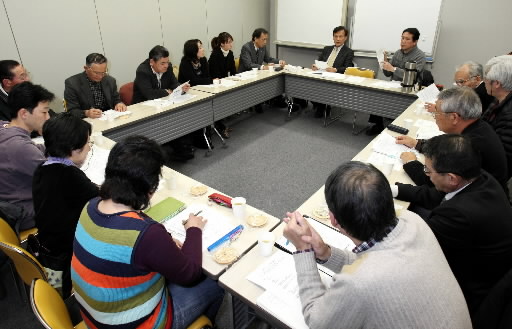Fukushima and Hiroshima: Two Years After the Great Eastern Japan Earthquake, Part 4
Mar. 21, 2013
Providing aid: People of all ages seek ways of maintaining support
by Michiko Tanaka and Yuichi Ishii, Staff Writers
An effort to hold concerts to support the reconstruction of the disaster-hit areas of eastern Japan was launched shortly after the Great Eastern Japan Earthquake struck. Dubbed “East Japan Aid,” the project was designed to last two years, and the upcoming concert on March 10 at the Hiroshima Industrial Hall in Minami Ward, Hiroshima will be the fifth and final event.
East Japan Aid came to life in April 2011, an effort organized by the Hiroshima association of citizens from Fukushima Prefecture and Hiroshima-based musicians. The participants prepared to dedicate themselves to staging a series of benefit concerts over the course of two years.
Hyoji Shimada, 75, chairman of the Fukushima citizens’ group, said, “We have done all that we can. It’s time to bring this effort to an end.” Because organizing concerts and selling tickets demands so much energy, they were forced to create some kind of time frame for their work.
A total of 1.08 million yen was raised from their second concert, including ticket sales and donations, and 850,000 yen from their fourth event. The money was sent to disaster response centers in Miyagi, Iwate, and Fukushima prefectures.
“We’ve achieved a certain degree of success,” Mr. Shimada said. “But I’m afraid that if we stop, the interest of people in Hiroshima will wane.” Once the project concludes, he will explore ways of continuing to lend support to the disaster-hit areas, making good use of the network he has established in Hiroshima.
This past February, the Hiroshima Prefectural Confederation of A-bomb Sufferers Organizations, chaired by Sunao Tsuboi, launched a fundraising campaign among their local chapters in the prefecture so that support for the disaster victims will not be fleeting. The money they raise will be sent to the town of Namie, in Fukushima Prefecture, whose residents have been forced to live elsewhere following the accident at the Fukushima No. 1 (Daiichi) nuclear power plant.
The organization is taking this step because interest in aiding the victims, which was very high in the aftermath of the accident, seems to be fading. Toshiyuki Mimaki, 70, secretary-general of the organization, said, “Even if we raise only a small amount of money, we want to show, as victims of radiation damage ourselves, that our hearts are always with them.”
Ten members of a project designed to aid people of the Tohoku region, launched by students at Hiroshima University of Economics, visited nursery schools in Iwaki, Fukushima Prefecture, in February and September of last year, and read picture books to the children there.
Shinetsu Masamoto, 45, director of the Kodokan education project center at the university, is working to support these kinds of efforts by the students. “There was great significance in the fact that students from Hiroshima visited Fukushima,” he said. He hopes that the students’ activities will continue to produce fruitful results.
(Originally published on March 7, 2013)
by Michiko Tanaka and Yuichi Ishii, Staff Writers
An effort to hold concerts to support the reconstruction of the disaster-hit areas of eastern Japan was launched shortly after the Great Eastern Japan Earthquake struck. Dubbed “East Japan Aid,” the project was designed to last two years, and the upcoming concert on March 10 at the Hiroshima Industrial Hall in Minami Ward, Hiroshima will be the fifth and final event.
East Japan Aid came to life in April 2011, an effort organized by the Hiroshima association of citizens from Fukushima Prefecture and Hiroshima-based musicians. The participants prepared to dedicate themselves to staging a series of benefit concerts over the course of two years.
Hyoji Shimada, 75, chairman of the Fukushima citizens’ group, said, “We have done all that we can. It’s time to bring this effort to an end.” Because organizing concerts and selling tickets demands so much energy, they were forced to create some kind of time frame for their work.
A total of 1.08 million yen was raised from their second concert, including ticket sales and donations, and 850,000 yen from their fourth event. The money was sent to disaster response centers in Miyagi, Iwate, and Fukushima prefectures.
“We’ve achieved a certain degree of success,” Mr. Shimada said. “But I’m afraid that if we stop, the interest of people in Hiroshima will wane.” Once the project concludes, he will explore ways of continuing to lend support to the disaster-hit areas, making good use of the network he has established in Hiroshima.
This past February, the Hiroshima Prefectural Confederation of A-bomb Sufferers Organizations, chaired by Sunao Tsuboi, launched a fundraising campaign among their local chapters in the prefecture so that support for the disaster victims will not be fleeting. The money they raise will be sent to the town of Namie, in Fukushima Prefecture, whose residents have been forced to live elsewhere following the accident at the Fukushima No. 1 (Daiichi) nuclear power plant.
The organization is taking this step because interest in aiding the victims, which was very high in the aftermath of the accident, seems to be fading. Toshiyuki Mimaki, 70, secretary-general of the organization, said, “Even if we raise only a small amount of money, we want to show, as victims of radiation damage ourselves, that our hearts are always with them.”
Ten members of a project designed to aid people of the Tohoku region, launched by students at Hiroshima University of Economics, visited nursery schools in Iwaki, Fukushima Prefecture, in February and September of last year, and read picture books to the children there.
Shinetsu Masamoto, 45, director of the Kodokan education project center at the university, is working to support these kinds of efforts by the students. “There was great significance in the fact that students from Hiroshima visited Fukushima,” he said. He hopes that the students’ activities will continue to produce fruitful results.
(Originally published on March 7, 2013)








